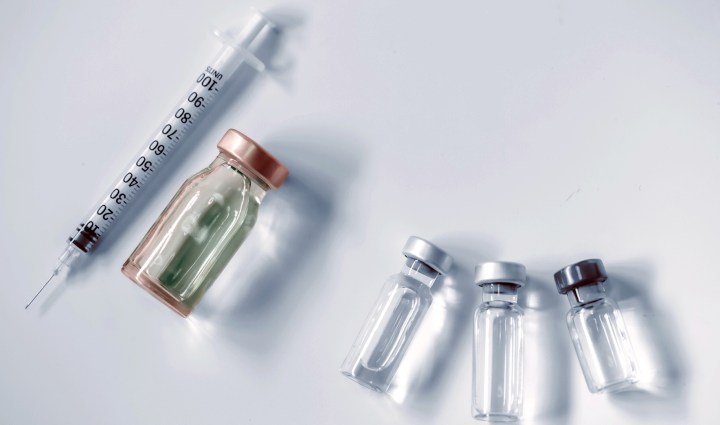SPOTLIGHT
Pilot projects set to inform rollout of HIV prevention shot but affordability remains in doubt

The bi-monthly shot likely outperformed the pills, the World Health Organization explains in new guidelines, mainly because it was easier for people to get an injection every two months than to take the pills every day.
South Africa is expected to begin piloting the HIV prevention injection early next year as one of several projects that experts hope will reveal the answers to some of the biggest questions about the future of the shot — who will deliver the injection, where, and how to sell people on the idea that just six shots a year could protect them from HIV.
Recently, Spotlight reported that the Wits Reproductive Health and HIV Institute (Wits RHI) and the national health department are expected to begin providing the injections of the long-acting formulation of the antiretroviral cabotegravir to young women early next year. The HIV prevention shot is expected to be offered alongside two other forms of HIV pre-exposure prophylaxis (PrEP) — the once-daily HIV prevention pill commonly known by its brand name Truvada and a relatively new vaginal ring to prevent infection. Inserted at home, the monthly ring was found to reduce women’s risk of contracting HIV by between 27% to more than half, according to the World Health Organization.
Several other demonstration projects featuring the relatively new trio of HIV prevention options are expected to follow in the pilot’s footsteps.
Every-other-month shot an easy option for people who don’t like pills
The pill is already available at more than 2,000 public sector sites nationwide. When taken correctly, the pill can reduce a person’s risk of contracting HIV by almost 99%. Still, a duo of large clinical trials led in part by South African researchers found that people who were given an injection of the antiretroviral cabotegravir every other month were about 80% less likely to contract HIV than those on the HIV prevention pill. The bi-monthly shot likely outperformed the pills, the World Health Organization explains in new guidelines, mainly because it was easier for people to get an injection every two months than to take the pills every day.
But South Africa — like the rest of the world — will have to answer major practical questions about how to provide and market the shot before a national rollout of the injection, including who will provide it and where and how to get people to use it.

Dapivirine vaginal ring and tablets of oral PrEP medication. (Photo: NIH Image Gallery / Spotlight)
To ensure the health department gets those answers, it will be closely coordinating pilot projects, according to national health department HIV prevention technical advisor Hasina Subedar. Subedar spoke to Spotlight in July at the International Aids Conference.
The South African Health Products Regulatory Authority (Sahpra) is expected to approve the HIV prevention shot for use in the country early next year. This after drugmaker ViiV Healthcare submitted its application for regulatory approval in late November 2021.
Sahpra’s approval will spell out who can receive the HIV prevention shot and who can administer it, depending on how Sahpra schedules or classifies the injection. In particular, many will be watching to see whether the injection will be made available to pregnant and breastfeeding people, who remain at high risk for contracting HIV in South Africa.
For safety reasons, many clinical trials initially exclude pregnant or breastfeeding people until scientists are sure medicines or vaccines are effective. Only when data show products are safe and effective, do researchers generally begin studying whether products are safe to use in pregnant people and their foetuses. Early data presented at the International Aids Conference in July suggests that the injection is safe to use during pregnancy, but further research on safety in pregnant and lactating people is ongoing.
Injection could be rolled out within six months of national guidelines
Once Sahpra has approved the drug, the National Essential Medicines List Committee goes to work. This expert body does an additional review of data, including around implementation before issuing recommendations to the health department about national guidelines. Guidelines developed by a guideline committee will determine how the department trains healthcare workers to provide the shot and how it structures public awareness campaigns.
Subedar admits it is difficult to predict exactly when the HIV prevention shot will be widely available. Still, she says that — based on the country’s experience with the HIV prevention pill — that the public health sector could begin offering the shot in as little as three to six months after national guidelines are finalised.
That is if South Africa can afford it.
Visit Daily Maverick’s home page for more news, analysis and investigations
Price remains single biggest factor
In the United States, the injection’s official price tag can be as high as R391,000 per patient per year. ViiV Healthcare has agreed to allow at least three generic medicines producers to provide affordable versions of the injection to low and middle-income countries as well as countries in sub-Saharan Africa. However, it could take as long as five years for generic versions to be ready for distribution. Until then, ViiV Healthcare has committed to affordable pricing for countries like South Africa but has declined to publicly confirm to Spotlight what price it will charge in South Africa.
Research recently published in The Lancet medical journal found that for the HIV prevention injection to be cost-effective in South Africa, it should cost no more than R1,800 per person per year. ViiV Healthcare previously told Spotlight that the price is unrealistic.
Subedar called cost — and cost-effectiveness — the single biggest factor in deciding the fate of the HIV prevention shot in South Africa.
“If the product is too expensive,” Subedar told Spotlight in July, “it’s going to really affect our ability to make it available across the country.”
‘I can send pills by courier, but I can’t do that with a bottle of cabotegravir’
For a decade, South Africa has invested heavily in moving HIV prevention and care out of hospitals and clinics and closer to communities. Providing medicine closer to home, research shows, often makes it more convenient for people and helps decongest busy clinics.
Today, you can get three-month supplies of the HIV prevention pill via courier, mobile clinics, or even fast-tracked queues at clinics depending on where you live.
Many of these services are provided by non-governmental organisations like the Desmond Tutu Health Foundation or Wits RHI, which partner with the health department.

Prof Linda-Gail Bekker.
(Photo: Facebook)
But figuring out how to provide the HIV prevention shot every other month outside of health facilities is tricky, admits Desmond Tutu Health Foundation Chief Operating Officer Dr Linda-Gail Bekker.
“That is one of the biggest implementation science questions that we need to answer and quickly,” she says. “I can send pills by courier, but I can’t do that with a bottle of cabotegravir.
“Suddenly, now you need a nurse who is specially trained to give an injection, which needs privacy — be it only every two months — but still, for that, you need infrastructure.”
Where will you be able to get the HIV prevention shot?
Bekker says the Desmond Tutu Health Foundation will be looking at piloting the injection in community “shot clinics,” using simple trailers staffed by a nurse and counsellor. Patients popping in for injections every two months could also get contraception, treatment for sexually transmitted infections, or other routine vaccinations like that for the human papillomavirus, which is linked to some forms of cervical cancer.
Meanwhile, research institute Ezintsha hopes to pilot the jab in Clicks pharmacies. Wits RHI says it will offer the shot via its mobile clinics and in the public facilities it already supports. Ezintsha and Wits RHI confirmed that both pilots are slated to offer all three forms of PrEP — the shot, the pill, and the vaginal ring.
At least initially, pharmacists and nurses already trained to initiate and manage patients on antiretrovirals, including PrEP, will likely be tasked with administering the shot. In the case of nurses, these scarce healthcare workers are often known as Nimart nurses. The acronym is short for Nurse Initiated Management of Anti-Retroviral Treatment. Today, these nurses — alongside doctors and specially trained pharmacists — already start and manage patients on the HIV prevention pill.
Still, relying on scarce Nimart nurses to provide oral PrEP has limited the HIV prevention pill’s availability and integration into other health services, wrote Bekker and other experts in July in The Lancet.
In the last six years, only about 569,977 people in South Africa have ever started on the HIV prevention pill, according to data collected by the HIV advocacy organisation, AVAC.
Experts generally agree that the HIV prevention injection will — like oral PrEP — need to be provided alongside other sexual and reproductive health services.
But Bekker says the HIV prevention injection may push researchers and health officials to get even more creative with how they bring the shot closer to communities. “We might have to come up with a new array of … service delivery models,” she says.

Wits RHI’s mobile PrEP clinic. (Photo: Project PrEP, an initiative funded by Unitaid, and implemented by Wits RHI / Spotlight)
How to tell the changing story of HIV prevention: It’s about more than just numbers
In the last decade, the world has seen the debut of a pill, a ring, and now an injection that can slash people’s risk of HIV infection.
All three are effective at preventing infection.
Still, they performed differently in clinical trials. The HIV injection technically outperformed the pill in trials because it was easier to take than a daily tablet. In clinical trials, the vaginal ring still cut women’s HIV risk by about a third. And although the ring resulted in even bigger reductions in HIV risk in the real world, poorer than expected clinical trial results seemed to dampen donors’ appetite to fund the technology, albeit at least temporarily, some advocates say.
Watch: My PrEP video diary
Wits RHI linkage to care officer Khanyi Kwatsha spends her days talking to young people about the HIV prevention pill. After fielding dozens of questions about the pill’s possible side-effects, she took to YouTube to chronicle her own journey on the HIV prevention pill. (Video courtesy of Project PrEP, an Unitaid-funded initiative, implemented by Wits RHI.)
But effectiveness is not the only thing that drives people’s decision to start PrEP or their choice in type of PrEP, says Wits RHI Director of Implementation Science Dr Saiqa Mullick.
In Johannesburg, Khanyi Kwatsha is a Wits RHI linkage to care officer. She spends her time helping young people navigate accessing and taking PrEP out in communities, on the phone, or via a dedicated WhatsApp chat line. Questions can range from what mild side effects to expect, how to take a break from PrEP when young people no longer feel at risk, or how to access services for the survivors of gender-based violence.
PrEP, she says, should be like ordering off a menu.
“The important thing is to show people that these PrEP methods are not in competition,” says Kwatsha, who adds that every PrEP site should ideally be able to offer all three PrEP options in the future. “It’s a matter of knowing which one works best for you and just having the information so that you can make an informed choice about them.”
Meanwhile, the first decade of the HIV prevention pill has taught healthcare workers and researchers another important lesson — hope is a better motivator than fear.
“In the past, the messaging was maybe more about instilling fear — saying if you don’t take this, you’re going to get HIV,” Mullick explains. “The field has learned a lot about how to message new PrEP — positioning it as a wellness product.
“We’re looking at messaging to say — your HIV risk, your health, your well-being is something that you have the power to take into your own hands,” she says. “Empowering messaging works, and that’s a big thing.” DM/MC
This article was published by Spotlight – health journalism in the public interest.






















 Become an Insider
Become an Insider
Comments - Please login in order to comment.